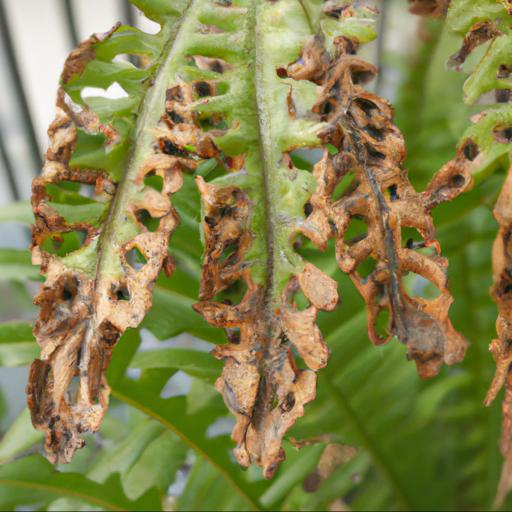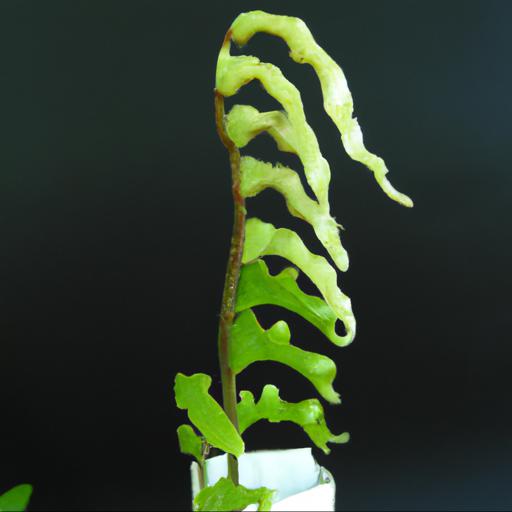Introducing Phlebodium aureum, a beautiful and unique fern species native to tropical and subtropical regions. This fern is an evergreen perennial, featuring bright green fronds that can reach up to three feet in length.
Phlebodium aureum is a popular choice for indoor and outdoor gardens, adding a lush and tropical feel to any space. It is an easy to care for plant, requiring minimal maintenance and making it a great choice for gardeners of all levels. It is also known for its air-purifying properties, helping to keep your home or office clean and healthy.
With its lush foliage and air-purifying properties, Phlebodium aureum is a great choice for any garden.
Benefits of growing phlebodium aureum
When it comes to bringing a unique, luscious green touch to your garden, look no further than the beautiful Phlebodium aureum. Also known as the Blue Star Fern, this particular species of fern is native to tropical and subtropical areas throughout North and South America, and is perfect for those who wish to inject a touch of tropical vibrancy into their garden. Known for its bold, bright blue underside and wavy green frond, the standout beauty of the Phlebodium aureum will bring a touch of the exotic to your garden.
Not only that, but this fern is relatively low maintenance and can be grown in a number of different settings. It is the perfect choice for those who are looking for something visually stunning without having to invest a lot of time and energy in caring for them.
The Phlebodium aureum is a hardy species of fern, capable of surviving in a range of different outdoors conditions and environments. Plus, with an easy to care for semi-deciduous leaves, it is sustainable in both dry and humid areas; making it a great choice for nearly any indoor or outdoor space. Whether it’s being grown in an outdoor container, a shady terrace, or small balcony, this stunning fern is sure to be a stunning display for years to come.
So why not give it a try and spruce up your outdoor space?
Tips for growing phlebodium aureum
Ah, Phlebodium aureum, the tropical evergreen fern that’s known for its fluffy blue-green foliage. Far from remaining in the realm of the fantasy garden, this plant is a must-have for any contemporary garden! Growing Phlebodium aureum is far from difficult.
With the right light and providing the right care routine, this fern can thrive even in your own front courtyard. When growing Phlebodium aureum, light is key.
The plant grows best in bright light or partial shade, although some gardeners prefer to keep it in full shade too. For best results, try to make sure that the soil is consistently moist without becoming waterlogged. A light, airy soil that’s made up of peat, perlite, and regular garden compost is ideal.
When it comes to fertilizing, a balanced fertilizer that’s meant for outdoor plants should do the trick. For those living in more temperate climates, the best time to transfer your Phlebodium aureum indoors is during fall or winter.
If you live in an area that experiences frost or snow, you’ll want to move it indoors during these times. During the warmer months or if you’re growing this fern indoors, try to maintain a consistent temperature, as it may suffer from rapid fluctuations.
When it comes to pests and diseases, Phlebodium aureum is relatively low-maintenance. As with any plant, be sure to check for aphids, slugs, and other common garden pests. To take care of any problems, use a gentle insecticidal soap before resorting to any harsh chemical pesticides.
Overall, growing Phlebodium aureum is a great choice for any gardener. Its attractive foliage and relatively easy maintenance routine makes this a must-have for any garden. With the right care and light requirements, you’ll be sure to have a healthy and vibrant fern year after year.
Common problems with phlebodium aureum

As a UK garden expert, it is important to be aware of the common problems that can arise when growing the tropical fern species, Phlebodium aureum. This enchanting and exotic fern, also known as the ‘blue-star fern’, can be found in shady, humid areas, and is an evergreen species that is ideally grown indoors or shaded areas of gardens that rarely freeze. It thrives in warm temperatures and indirect light, but occasionally can suffer from issues.
Due to its lack of reliable hardiness, Phlebodium aureum is particularly vulnerable to a number of issues, in particular, over-watering, root-rot, and mealybugs. A case of over-watering is easily identifiable as the leaves of the fern will develop brown spots and start to droop.
To solve this problem, it is important to allow the soil to dry out before watering the fern again. Allowing the foliage to dry out is also important, as it will help the fern retain moisture, and help prevent soil-borne diseases. Finally, mealy bugs are insect pests that feed on the roots of the fern and can, unfortunately, be difficult to detect as they can often hide amongst the leaves.
An effective way to deal with this issue is to allow 1 cup of white vinegar to dissolve in 1 gallon of water, then, spray the fern with this substance twice a week for 1 to 2 months. This will contribute to controlling the mealy bug population.
In conclusion, Phlebodium aureum is an incredibly beautiful, yet fragile, fern species, that although can suffer from a number of problems if not properly looked after, can be grown successfully with the correct care and attention. Issues such as over-watering, root-rot and mealybugs are common and can be managed by following the above guidelines.
Our video recommendation
Bottom Line
Phlebodium aureum, also known as the Blue Star Fern, is an attractive, low-maintenance houseplant with blue-green fronds. It requires bright indirect light, regular watering, and occasional misting to thrive. This plant is easy to care for and is a great choice for novice gardeners.
With its unique frond shape and color, it is sure to add a touch of beauty to any home.
FAQ
What are the ideal conditions for Phlebodium aureum to thrive?
The ideal conditions for Phlebodium aureum to thrive include bright, indirect light, high humidity, and consistently moist, well-draining soil.
How often should Phlebodium aureum be watered?
Phlebodium aureum should be watered every 7-10 days, allowing the soil to dry out between waterings.
What type of soil is best for Phlebodium aureum?
Well-draining, slightly acidic soil with a pH of 5.5 to 6.5 is best for Phlebodium aureum.
How much light does Phlebodium aureum need?
Phlebodium aureum needs bright, indirect light, but can tolerate some shade.
What are the common pests and diseases associated with Phlebodium aureum?
Common pests and diseases associated with Phlebodium aureum include mealybugs, spider mites, scale insects, and root rot.
How can Phlebodium aureum be propagated?
Phlebodium aureum can be propagated by division of the rhizome or by stem cuttings.

